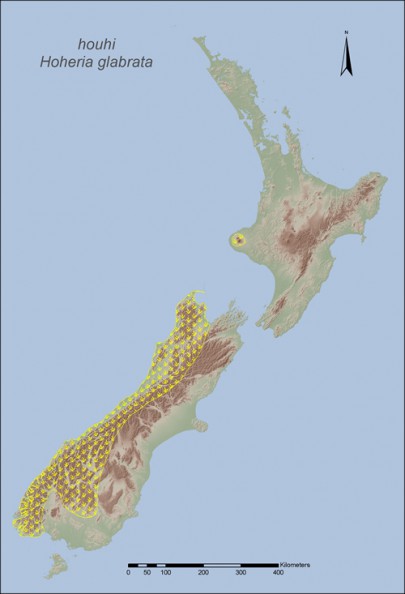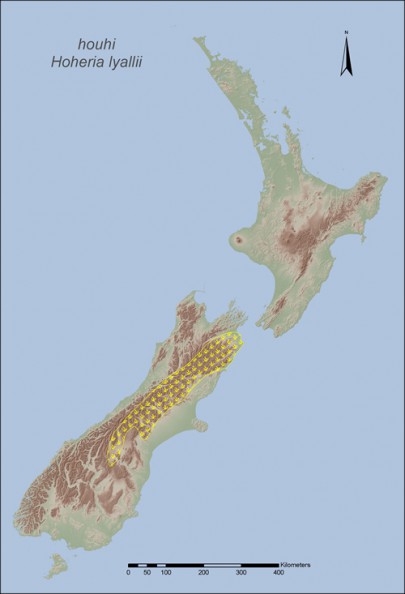Houhere – Lacebark
In this section
| Māori names | houhere, houhi, and similar variants. Lowland ribbonwood is mānatu |
|---|---|
| Other common names | lacebark, ribbonwood |
| Scientific name | Hoheria populnea, Hoheria sexstylosa, Hoheria angustifolia, Hoheria glabrata and Hoheria lyallii. Mānatu is Plagianthus regius |
| Family | Malvaceae (mallow family) |
The lace-like inner bark of houhere is used for fine, decorative weaving – kete, headbands, trim on hats and cloaks. The bark was sometimes twisted and plaited into ropes.
Distribution
The lacebarks and ribbonwoods encompass a group of small to medium-sized graceful forest trees from the mallow family. Mānatu is the tallest at up to 15 m, while the Hoheria species grow to about 10 m tall, although much smaller where the two mountain species reach the subalpine zone. Branches are generally slender and upright producing compact crowns.
Mature foliage
Leaves in all species are mid- to dark green above and paler underneath, with fine yet obvious vein networks. All the leaves are serrated. In H. populnea and H. sexstylosa the adult leaves are slightly leathery and broadest near their midpoints. Leaves of the adult narrow-leaved lacebark are small and narrow. Mountain ribbonwoods have soft foliage often with heart-shaped leaf bases with deep rounded serrations.
Foliage of the lowland and mountain ribbonwoods is deciduous in winter, an unusual feature in the New Zealand flora.
Young foliage
All young houhere have foliage that differs markedly from the adult foliage. Juvenile foliage is only a quarter to half as long as adult foliage, is usually as broad as it is long, and possesses prominent rounded serrated margins that are, with the exception of narrow-leaved lacebark, often deeply lobed.
The young foliage is generally sparse on long, very slender branches that, in lowland ribbonwood and narrow-leaved lacebark, intertwine forming springy ‘divaricate’ bushes. Foliage gradually changes to adult form at heights ranging up to 3 m above the ground. Many ecologists believe these juvenile life-stages are adaptations that reduced the impact of moa browsing.
Flowers and seeds
Hoheria species produce beautiful white scented flowers in summer or autumn, rising either singly or in clusters from the leaf axils. Fruit are 5−7 dry seeds fused together, each seed encased in a broad wing, or in mountain ribbonwoods 10−15 seeds without prominent wings.
The flowers of mānatu are small, pale green, and borne abundantly on a much branched delicate infloresence (flowering branch) up to 25 cm long.
Lacy inner bark
A feature common to all houhere species, and that responsible for their English names, is a fibrous inner bark. Tiny growths of the outer layer of wood penetrate through this fibrous layer, giving it a lacy appearance. This layer is difficult to separate from the surrounding tissue in green bark, but readily comes away from both the bark and wood, in several very fine layers, when dead and dried.
Distribution and ecology
Each species of lacebark has a distinctive distribution in the wild.
Mānatu is more widely distributed in coastal and lowland forests from Kaitaia southward, but tends to be rather local on stream banks and alluvial terraces. It is also a popular garden and park specimen.
H. angustifolia (houhi puruhi), narrow-leaved lacebark, occurs naturally in forests up to 900 m above sea level, mainly in drier eastern districts. Although recorded from the Wairoa River (Northland) and Waitomo (Waikato) areas, it is only common in the southern North Island and in the South Island.
All lacebark species are fast-growing trees that establish on disturbed sites in or at the margin of forest. Rapid growth rates led some early observers to suggest that these trees may make useful commercial pulp crops for paper making. The mountain ribbonwoods often form groves on slips and avalanche paths. Vigorous resprouting following severe damage permits these mountain species to persist on such sites despite repeated or extreme disturbance.
Pest threats
Houhere can be heavily infested by stem galls caused by a mite (Eriophyes hoheriae).Galls are typically rough-surfaced spheres of 1−2 cm on small stems and twigs, and apparently cause little harm. They are particularly common on H. populnea, but can affect other houhere species as well.
H. populnea is also prone to hoheria dieback, which kills parts of the crown and for which there is no cure. The disease is associated with and possibly caused by the native heart rot fungus, Agrocybe parasitica.
All houhere species are palatable to goats, deer and possums, which threaten some localised varieties such as the ‘Tararua’ hoheria. Seedling and saplings tend to be scare in the presence of these introduced browsers.
Propagation
The lowland species are easily grown from fresh seed. Seedlings are often numerous near garden specimens. Germinate in autumn and provide shelter over the first winter. Plant out after the last frost the following spring or summer. Cutting and layering techniques can also be successfully employed.
Lacebarks and ribbonwoods will grow in any well-drained soil. They prefer a sunny or partly shady location and are wind hardy. H. sexstylosa is the least adaptable, and prefers damp soil and a sheltered location at least until it becomes established. Mountain ribbonwoods are also best grown from fresh seed. They prefer damp soils, a sunny site, and a cool climate, and dislike humidity. They will not flower in warm climates unless subjected to cold treatment.

![Narrow-leaved lacebark ([H. angustifolia]), leaves and seeds. Image - Peter Sweetapple Image](/assets/Tools-And-Resources/collections/Weaving-plants/Houhere_2__FillMaxWzE1LDE1XQ.jpg)
![Mountain ribbonwood ([H. lyallii]), foliage and seed. Image - Peter Sweetapple Image](/assets/Tools-And-Resources/collections/Weaving-plants/Houhere_3__FillMaxWzE1LDE1XQ.jpg)
![[Hoheria sexstylosa], foliage and flowers. Image - Peter Sweetapple Image](/assets/Tools-And-Resources/collections/Weaving-plants/Houhere_5__FillMaxWzE1LDE1XQ.jpg)
![Green inner bark of narrow-leaved lacebark ([H. angustifolia]). Image - Peter Sweetapple Image](/assets/Tools-And-Resources/collections/Weaving-plants/Houhere_6__FillMaxWzE1LDE1XQ.jpg)
![Stem galls on houhere ([Hoheria glabrata]) caused by the mite [Eriophyes hoheriae]. Image - R.E. Beever Image](/assets/Tools-And-Resources/collections/Weaving-plants/Houhere_9__FillMaxWzE1LDE1XQ.jpg)

![[Hoheria populnea] (houhere) is found in coastal and lowland forests in the upper North Island, north of about Hamilton. [Hoheria populnea] (houhere) is found in coastal and lowland forests in the upper North Island, north of about Hamilton.](/assets/Tools-And-Resources/collections/Weaving-plants/hoh_pop_500__ResizedImageWzQwNSw1OTRd.jpg)
![[Hoheria sexstylosa] (houhi ongaonga) occurs in lowland to montane forests from Warkworth southward to Canterbury. [Hoheria sexstylosa] (houhi ongaonga) occurs in lowland to montane forests from Warkworth southward to Canterbury.](/assets/Tools-And-Resources/collections/Weaving-plants/hoh_sexst_500__ResizedImageWzQwNSw1OTRd.jpg)

